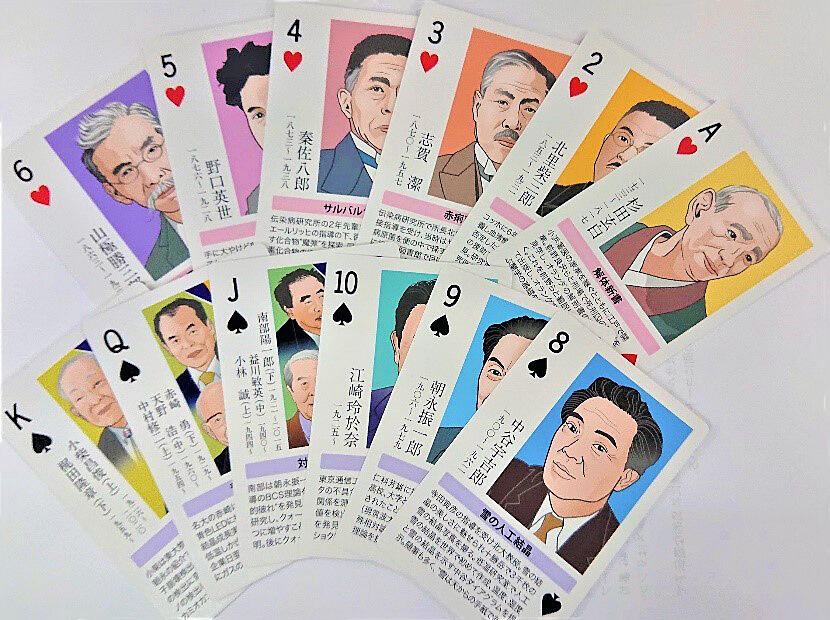Each year, the Japan Society for the Advancement of Inventions (JSAI) produces science playing cards so that people can have fun as they learn about the essence of science. This year, they have focused on Japanese scientists and engineers who accomplished outstanding achievements, and created "Japanese Scientist and Engineer Playing Cards" that let people enjoy themselves while learning about the major inventions and discoveries that these great people made. These cards are given free of charge to students who make it to the final selections of science and engineering contests, such as Science Koshien, or if they will be used in classes in elementary and junior high schools. You can also buy them in museum shops, such as at the National Museum of Nature and Science and the National Museum of Emerging Science and Innovation (Miraikan), on Amazon, and on the JSAI website.

Until now, JSAI has created a variety of playing cards, including DNA cards, periodic table cards, electricity cards, Newtonian Mechanics cards, and cards featuring famous people in science and engineering, enabling children to familiarize themselves with science and technology from a young age through play, and to enhance their abilities and motivation for science. JSAI has also run guest-led classes in elementary and junior high schools using these science playing cards. The schools that have been provided with science playing cards carry out lessons in which students learn while enjoying themselves with the cards, and these have positive reviews from both teachers and students.
After WWII, Japan had numerous successes in technological development, and grew into an economic power--there were many excellent engineers behind these accomplishments. Japan's contributions in the field of science have also been valued, and we have repeatedly produced Nobel Prize winners. This time, the playing cards focus a spotlight on the great people who were responsible for Japan's scientific and technological progress.
In the Edo period (1603-1868), information about Europe's latest science and technology did not enter Japan because the country was closed to the outside world, but excellent and original science and technology was created within Japan. Seki Takakazu established Japanese mathematics (wasan), developing a method that made it possible to calculate higher-degree equations with multiple unknowns that are related to algebra. Hanaoka Seishu, a medical practitioner, discovered anesthetic, and successfully performed the world's first operation using anesthesia. Ino Tadataka walked all over Japan and created a map; his measuring techniques were among the best in the world. Tanaka Hisashige, the master maker of mechanical dolls (karakuri ningyo) and who was known as Karakuri Giemon, created the Myriad year clock, which is considered to be the pinnacle of Edo technology.
After the Meiji Restoration (1868), the government invited many scientists and engineers to Japan as advisors to assist in Japan's modernization, and attempted to absorb the modern science that was advancing in Europe and America. Meanwhile, outstanding young people were sent to Europe and America as government-sponsored exchange students, thus fostering academics who would be responsible for Japan's science and technology.
Kitasato Shibasaburo succeeded in obtaining a pure culture of tetanus bacillus under Heinrich Hermann Robert Koch, and developed serotherapy. Under Paul Ehrlich, Hata Sahachiro developed Salvarsan, the magic bullet for syphilis, and paved the way for chemotherapy. Takamine Jokichi discovered Taka-Diastase and adrenaline in America, made a fortune, and was active as an industrialist. Going into the Taisho period (1912-1926), scientists accomplished feats that went down in science history, including Noguchi hideyo with yellow fever, Yamagiwa Katsusaburo with artificial cancer, and Suzuki Umetaro with vitamin D. Although these Japanese people were nominated for the Nobel Prize, no Japanese person received the Nobel Prize before WWII. Yukawa Hideki presented mesons, and his work was positively received; he became the first Japanese person to receive a Nobel Prize shortly after the end of the War.
This set of science playing cards places these great people in chronological order from the Edo period to the present day. Spades are for physics and math, hearts are for biological and medical science, diamonds are for chemistry, and clubs are for technology and inventions. Great people who were active at roughly the same time are on cards with the same numbers. The cards detail their names, dates of birth and death, career history, representative achievements and explanations therein, and also famous quotes from these people.
This article has been translated by JST with permission from The Science News Ltd.(https://sci-news.co.jp/). Unauthorized reproduction of the article and photographs is prohibited.




